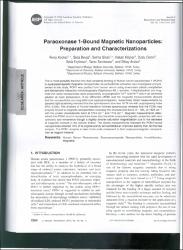Paraoxonase 1-bound magnetic nanoparticles: Preparation and characterizations

Göster/
Erişim
info:eu-repo/semantics/openAccessTarih
2010Yazar
Köçkar, FerayBeyaz, Seda
Sinan, Selma
Köçkar, Hakan
Demir, Dudu
Eryılmaz, Seda
Tanrısever, Taner
Arslan, Oktay
Üst veri
Tüm öğe kaydını gösterÖzet
This is most probably the first time that covalently binding of Human serum paraoxonase 1 (PON1) to superparamagnetic magnetite nanoparticles via carbodiimide activation was investigated and presented in this study. PON1 was purified from human serum using ammonium sulfate precipitation and hydrophobic interaction chromatography (Sepharose 4B, L-tyrosine, 1-Napthylamine) and magnetic iron oxide nanoparticles were prepared by co-precipitation Fe(+2) and Fe(+3) ions in an ammonia solution at room temperature. X-ray diffraction (XRD) and the magnetic measurements showed that the nanoparticles are magnetite and superparamagnetic, respectively. Direct measurements by dynamic light scattering revealed that the hydrodynamic size was 16.76 nm with polydispersity index (PDI: 0.234). The analysis of Fourier transform infrared spectroscopy revealed that the PON1 was properly bound to magnetic nanoparticles replacing the characteristic band of -NH(2) at 1629 cm(-1) with the protein characteristic band at 1744 cm(-1) and 1712 cm(-1). Magnetic measurements determined that PON1-bound nanoparticles have also favorable superparamagnetic properties with zero coercivity and remanence though a slightly smaller saturation magnetization due to the decrease of magnetic moment in the volume friction. The kinetic measurements indicated the PON1-bound nanoparticles retained 70% of its original activity and exhibited an improved stability than did the free enzyme. The PON1 enzyme is seen to be quite convenient to bind superparamagnetic nanoparticles as support material.

















